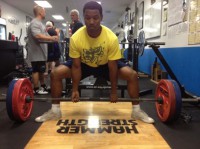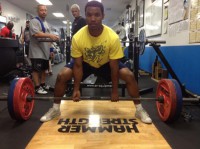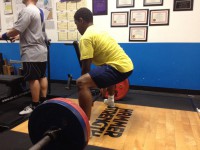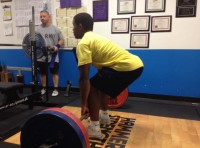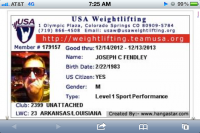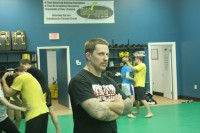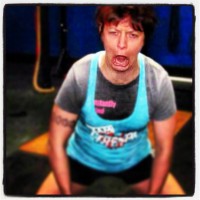Here’s the second installment of “AC teaches you how to do stuff more awesomely.” Last week, he went over some tips on how to press better. Today, he goes over how to coach a proper bench setup, and shows us a couple dozen nip slips. It’s fine. – Jacob
Have the athlete lay down on the bench (obviously). From there have them reach and grab the posts (like in the video) in order to pull their scapula (shoulder blades) together. Having them grab the posts can give them a better “pinch” then they might be able to do otherwise. Pulling the shoulder blades or scapula together artificially shortens the bench ROM as well as changing the angle of contraction for the pecs. If the shoulders are rounded out or flat, the chest contracts at an inward angle because of the attachment points at the shoulder and the middle of the chest. This causes the force to be applied at an inward angle. “Pinching” or retracting the scapula changes the angle of contraction so the force is applied in a more vertical, linear, fashion.
Once that is discussed you can simply sum all of that up by cueing the word “Pinch” or whatever you like. This is something that you talk to the athlete about ahead of time. Some guys like to hear “squeeze” instead.
From there, the athlete can now settle into his arch. What helps me when I arch is to try and think about getting my hips as close to my shoulders as possible. Again, this artificially shortens the bench ROM and allows for a better bar bath to the sternum. As I mentioned in the video, the arch and feet position can be done pretty much at the same time. There is literally no worry for risk of spinal injury from arching. Sometimes females can go into over-extension because they can be more mobile than a lot of guys. You might have to look for that if you coach any ladies. The only worry is cramping up at the low back and anterior hip, which proper mobility work can prevent. Anyone who says otherwise is an idiot. There is no compression of the spine at any point in time during the bench. The heels provide extra “drive” into the bar. Having them flat is important so they can “drive” or “dig” their feet into the ground. Having plantar flexion is basically adding a weak point in the chain. If they are on the balls of their toes, they can lose force production through the ankle. You just have to logically think “What can serve as a harder brace? My entire foot based on the floor, or the small surface area that I am pushing through with my calf?” The heels need to be slightly behind the knees. You can get a visual of that from the video I linked. Tell your lifter to “imagine you’re extending your knee to make your body slide up the bench” — NOT driving them so that the butt drives up to the ceiling. This solidifies the pinched upper back onto the bench and prevents any variability due to instability. That last part is courtesy of Jenn Thompson. She mentions it in her video and it’s a good take-home point. She is a really nice lady and I think I have a crush on her. (editors’s note – JT rules. <3)
After this is all discussed, you are going to sum it up with “Arch” and “Heels”.
When your athlete is setting up remind them. As a coach, you are a commanding presence, so cue the set up. “Heels!” “Arch!” “Pinch!” “Nice and tight!” The more emphasis on the set up, the easier the lift becomes. Justin likes to use the terms “Active Heel” and “Active Pinch.” Those are really good to cue because the set-up isn’t cemented. Guys can fall out of their arch and pinch, so during the set you have to actively maintain that position.
Some other info/cues that are equally important are:
Grip. When the lifter grips the bar, it should be a full grip. None of that suicide thumbless grip shit. I don’t care if they have been benching like since they began. It’s horse-shit and dangerous. From the coaches perspective (you!), the forearm should be at a 90 degree angle with the bar when the bar is on the chest (in other words, the forearms are vertical at the bottom of the rep). This puts the athlete at the most advantageous spot for the shortest distance for the bar path and the most musculature involved in the lift. As far as grip width goes, keep in mind that wider grips put a lot of stress on the elbows and shoulders and make it hard to stay externally rotated throughout the movement.
Elbows. This is very important. If they elbows “flare” out (which is called “Internal Rotation”), THIS IS BAD. You can do external/internal rotation reading this right now. Reach out in front of you and rotate your arms in. Your right hand rotates clockwise and the left goes counter clockwise. Basically, it’s like tucking in the elbows. You are stronger during any pushing when in external rotation. The cue to use is “Elbows to Ribs”. You can shorten that if you want to just “Elbows,” after you have explained it.
Finally, whenever I coach people, I try to make a point to tell them that the object is not to bounce the bar off your chest. The point is to lightly touch and “DRIVE” off the chest.
I think I covered it all. If you have a question about any of that, fire away.
Here’s a video of Justin explaining internal and external rotation:

